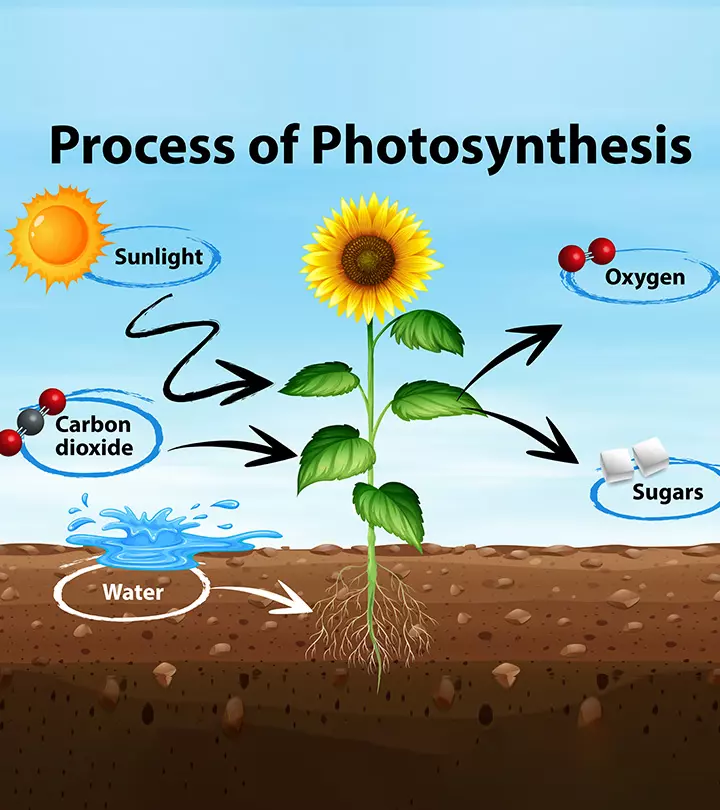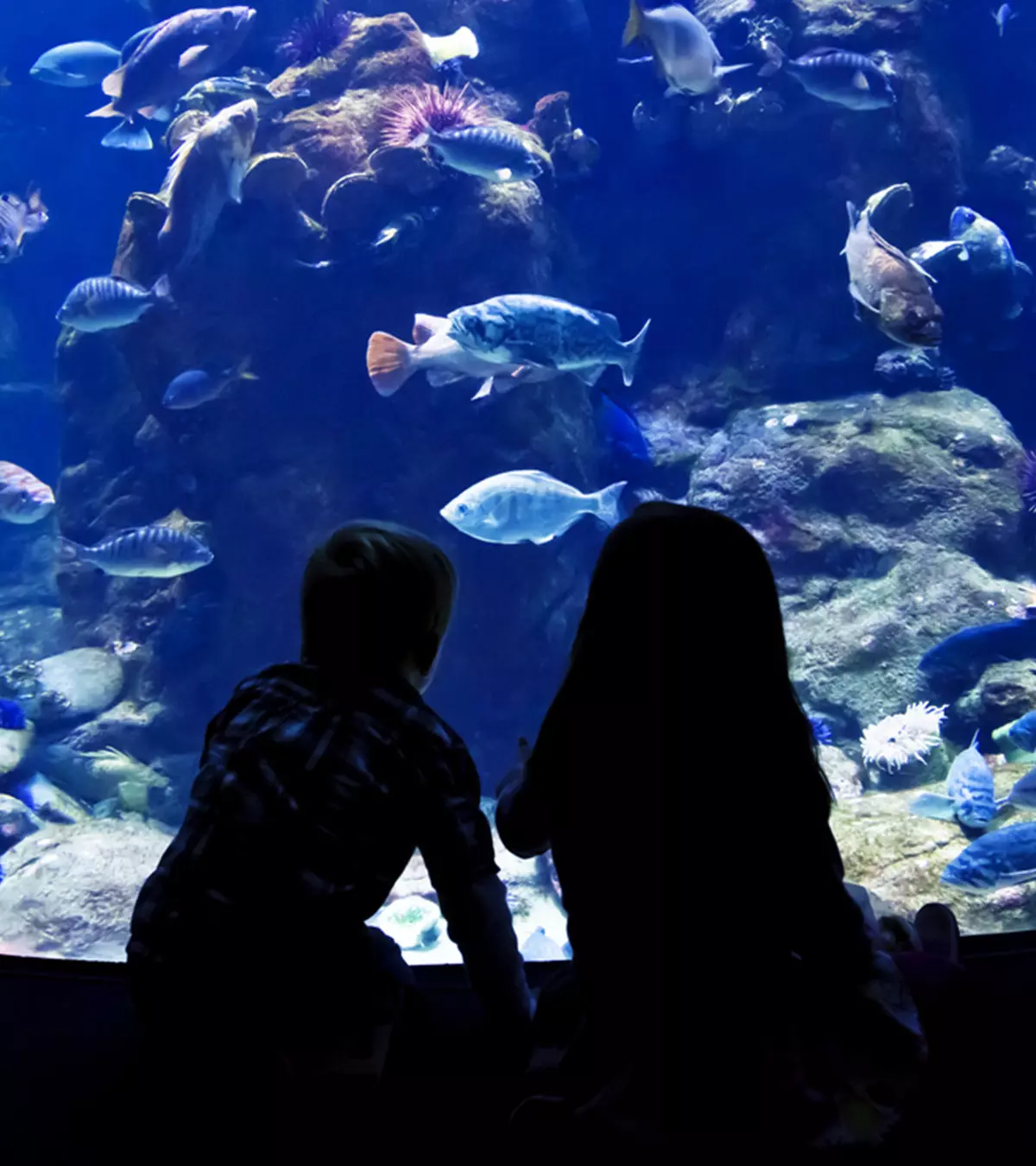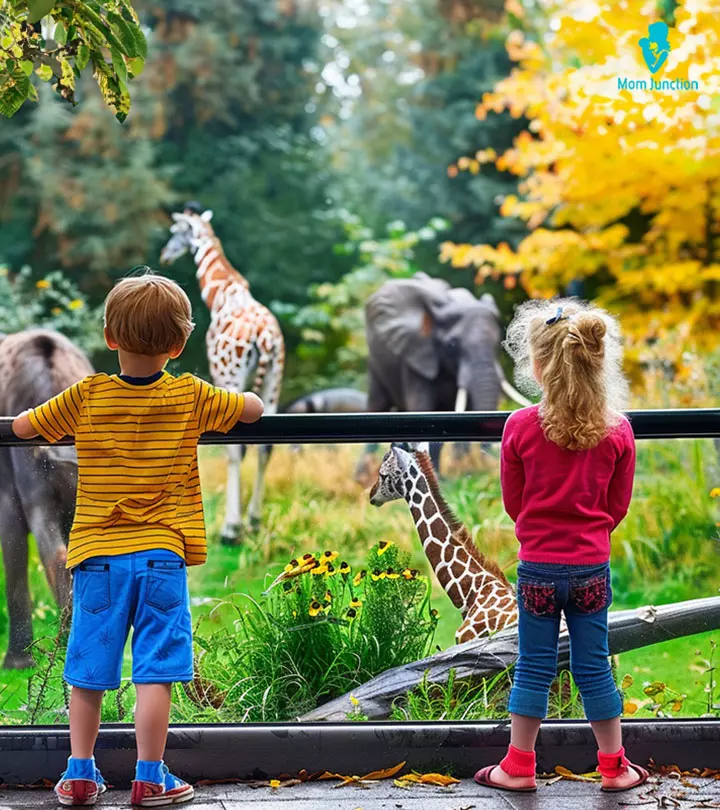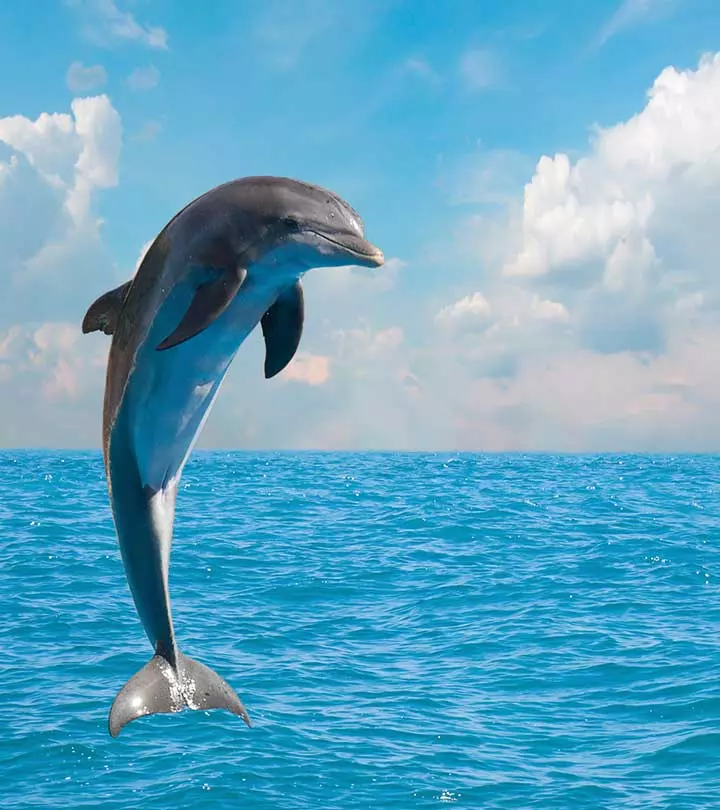
Image: Shutterstock
Who is the second smartest creature on the Earth after humans? Well, it’s dolphins (1). Dolphin facts for kids often leave them fascinated. This water mammal is friendly, fun-loving, and among the most intelligent beings on the planet. The marine creatures’ graceful movements and funny yet beautiful faces grab the attention of children and adults alike. Humans can easily bond with dolphins, make them do tricks, and put on a show.
But there are more exciting facts about them that can draw your children to these gentle creatures. Learning the facts about dolphins will mesmerize your child, feed their curiosity, and prompt them to explore more about sea creatures. Scroll down to discover some interesting facts.
Key Pointers
- Dolphins are smart mammals that exhibit a range of peculiar characteristics.
- Bottlenose dolphins are the most abundant species of dolphins found worldwide.
- It is not legal to feed dolphins in the US waters.
50+ Interesting Dolphin Facts For Kids
Read these fun facts about dolphins to your children and see them getting excited the next time they see this lovely aquatic animal on TV or phone.
- There are 36 species of dolphins found across the world in different aquatic environments like oceans, coastal, freshwater, and estuarine (2). They fall under the infraorder of aquatic animals called cetaceans.
- Dolphins live in social groups known as pods. The number of dolphins in a pod varies from 2 to 15.
- The most common dolphin species is the Bottlenose dolphin. They perform in many aquaria shows all over the world (3).

- The average length of adult dolphins is 2.59 meters or 8.5 feet. However, the large bottlenose dolphins in the Pacific can be as long as 3.7 meters or 12 feet and weigh 1,000 lbs. In the Mediterranean, bottlenose dolphins can be 3.7 meters or 12 feet, and some can grow even more than that (4).
- Dolphin skin does not have hair or sweat glands. The outer skin layer is about 15 to 20 times thicker than the epidermis of humans. Dolphin skin keeps flaking and peeling as new skin cells replace the old ones. The outermost skin layer of a bottlenose dolphin may be replaced at a two-hour interval (4).

- Every dolphin has a unique whistle that it develops shortly after birth. It is used for identification, like the names of humans. Dolphins also give out high-frequency clicks and act as a sonar system called echolocation(5).
- Bottlenose dolphins swim slowly and casually, moving about two miles per hour. However, they can also be fast sprinters and can achieve a speed of over 30 miles per hour for short periods (2)!
- Dolphins don’t drink water like humans. Instead, they receive the fresh water they require from the fish they consume.
- Dolphins employ their sonar to catch complex shapes and identify them visually. Their visual acuity and sonar capabilities make them easily evaluate different objects in their environment (6).
- A female dolphin is called a ‘cow’ while a male dolphin is known as a ‘bull.’
- Large dolphins can easily eat hundreds of pounds of fish daily. They never sleep long, hence requiring more calories to stay full.
- Dolphins feed on fish, squid, and shrimp. The group of dolphins traps fish by creating a mud ring, waiting outside the ring, and gulping back the fish (4).
- Bottlenose dolphin pregnancies last for around 12 months, just a little longer than human pregnancies. The baby dolphin or calf is usually born tail first to prevent the risk of drowning. Their birth happens in a couple of hours (7).
- During mating, adult male dolphins can turn aggressive and competitive. They fight other males or herd off the female to prevent them from becoming impregnated by other males.
 Did you know?
Did you know?- Marine traffic, seismic surveys, and underwater construction around the British Isles cause noise pollution and stress dolphins and severely hinder their ability to communicate and reproduce (2).
- Bottlenose dolphins may have 72-104 teeth. These mammals do not use their teeth to chew. Instead, the teeth catch food and swallow it whole (8).
- Bottlenose dolphins sleep half a brain at a time. They keep one of their eyes open, likely because they want to be close to their group.
- Dolphins have evolved from the ancestors of four-legged land mammals over 50 million years ago. One of the crucial changes to their evolution is the position of the nostril on top of their head. It is called a blowhole and enables them to exchange breathing air when they surface from the water (9).
- These sea mammals love to surf in the wakes and waves of boats and swim through the bubble rings that they make.
- Bottlenose dolphins are often troubled and killed by Gillnets, driftnets, purse seines, trawls, long lines, and hook-and-line gear used in fisheries (2).
- Dolphins can get trapped in the garbage humans leave on the beach. Trash like plastic shower hoses can get inside their bodies and kill them.
- Hector’s and Māui dolphins are some rarest kinds of dolphins. Māui dolphins are only four feet long, just as much as a human child!
- Māui and Hector’s dolphins can live only till their mid-20s. Their lifespan is way less than other dolphins and whales (10).

- Short-beaked common dolphins are one of the most familiar dolphins. This species is found in warm tropical to cool temperate waters, primarily offshore (11).
- The Amazon river dolphin, also called the Pink river dolphin, inhabits freshwater. It resembles a cat food sculpture and is less aesthetic than other species of dolphins (12).
- The Ganges river dolphin is a rare species of dolphin found particularly in India and Pakistan. Presently, not much is known about their habitats (13).
- The female Ganges river dolphins are larger than males. The maximum size of a female is 2.67 meters while a male dolphin is 2.12 meters long (13).
- Commerson’s dolphins are black and white. They are only 3.9 to 5.6 feet in length (14).
- Commerson’s dolphins have two population groups, one off the coast of southern South America and the other around the Kerguelen Islands. This population is regarded as a distinct subspecies (14).
- Another dolphin species is the rough-toothed dolphin. It does not possess a noticeable forehead, unlike other dolphins.
- Rough-toothed dolphins can stay underwater for up to 15 minutes. Their distinct trait is that they can adjust to captivity (15).
- The Risso’s dolphin is a large dolphin with a gray hide. This hide lightens with age and has scars on it.
- The killer whale is the largest of the dolphin species (16).
- Killer whales are the only dolphin species that attack sharks, whales, and big marine animals.
 Quick fact
Quick fact- Also known as Orcas, the killer whale is one of the longest-living dolphin species. Female Orcas may live for over 90 years (17).
- The Irrawaddy dolphin, also called the Mekong or Mahakam River dolphin, are 2-2.75 meters long (18).
- Dolphins usually live for over 60 years. Dolphins up to 48 years can also give birth (17).
- The Yangtze River dolphin or baiji dolphin is an obligate river dolphin in the middle-lower Yangtze River drainage and the neighboring Qiantang River in eastern China. Their population declined throughout the late twentieth century (19).
- Dolphins can recognize themselves in the mirror. It is one of the rare capacities that these mammals exhibit.
- Dolphins can use various tools, such as picking sponges to safeguard their snouts while they forage for food underwater.
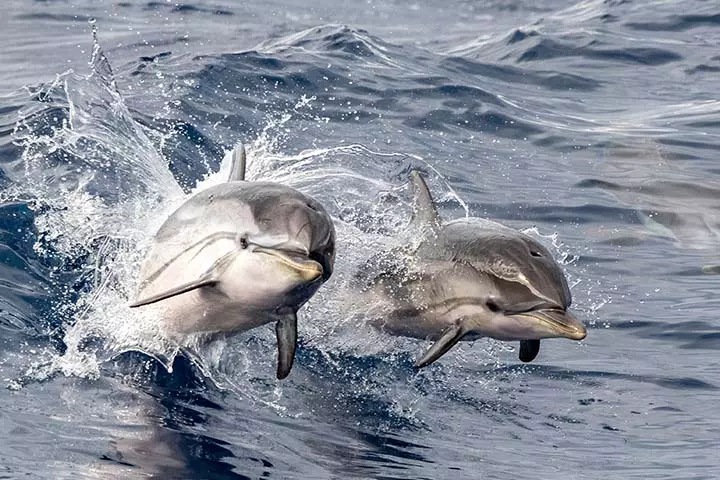
- It is illegal to touch or feed wild dolphins in the US waters. (20).
- Some dolphins have unfused necks and can turn their head a full 90 degrees.
- According to a 2019 review by the NOAA, 11 out of the 13 critically endangered small dolphin species are threatened by bycatch in gillnet fisheries (21) and are in desperate need of conservation.
- Some dolphins are blind. The Ganges river dolphin, for instance, relies heavily on sound for communication.
- Dolphin calves remain close to their mothers for a few years before becoming independent. But some calves stay with their mothers for a lifetime.
- Military programs have utilized the underwater sonar capabilities of dolphins to find humans and identify explosives underwater (22).
- The hourglass dolphin is a shy, elusive dolphin species. It shares a similar black-and-white color pattern as killer whales.

- Flipper, a bottlenose dolphin, was the world’s most famous dolphin known for its intelligence.
- Fishing accidents and the rising pollution and trash build-up in the Mediterranean Sea endanger the short-beaked common dolphin.
- Bottlenose dolphins can hold their breath for around 20 minutes (23).
- All dolphins have streamlined bodies shaped like elongated teardrops, i.e., larger front than back.
- They have a dorsal fin that acts like the keel of a boat, helping stabilize them in water and swim quickly.
Frequently Asked Questions
1. Why do dolphins have two stomachs?
Dolphins have two stomachs, as they cannot chew their food. While the first one keeps the food, it is the second stomach where the digestion takes place. Dolphins with one stomach are divided into three parts (24).
2. Do dolphins like to be touched?
If the dolphins want physical contact with people, they will initiate it. Humans who touch dolphins uninvited may disturb the dolphin’s behavior and make them leave the place.
3. What are some popular myths or misconceptions about dolphins, and what is the truth behind them?
One myth is that dolphins are always happy and friendly, but they can have different feelings and behaviors. Another myth is that dolphins are like humans, but they are different and have their own special ways. Some think it’s always safe to swim with dolphins, but it’s important to be careful and follow the rules to protect them. The truth is that dolphins are amazing creatures, and we should learn about them and treat them with care and respect in their natural homes.
4. How do dolphins hunt for food, and what are some of their unique hunting techniques?
Dolphins use different ways to catch their food. Sometimes they work together to surround and catch fish, and other times they use a special ability called echolocation to find their prey. Once they locate their food, they swim fast and skillfully to catch it. In a pod, they communicate with each other effectively to hunt prey and take turns to eat while swimming around the assembled prey in the middle.
5. Do dolphins have teeth?
Yes, dolphins have teeth. They use their teeth to catch and eat fish and other marine creatures (25).
6. What are the main threats to dolphins?
The existence of dolphins is mainly threatened by climate change, ship strikes, toxic contamination in the sea, entanglement in fishing gear, oil and gas development, habitat degradation, and whaling (hunting of whales and dolphins) (26).
Dolphins are one of the most lovely creatures on Earth. They are intelligent and like to play with humans. These interesting dolphin facts for kids will help cultivate a love of animals in children. They will get to know more about these friendly mammals and become more knowledgeable about these sea creatures. Apart from telling them these facts, you may show videos or make them work on dolphin coloring pages and then quiz them later. Such activities related to water animal information for kids will help sharpen their memory and keep them engaged.
Infographic: Ways to Protect Dolphins
Dolphins are one of the most endangered species. Factors like increasing sea temperature, pollutants in their habitats, and hunting have made their existence hard. But there are ways to help dolphins and prevent them from becoming extinct. In this infographic, you will find easy ways to help protect them. Illustration: Momjunction Design Team
Illustration: Fun And Fascinating Dolphin Facts for Kids

Image: Stable Diffusion/MomJunction Design Team
Dive into the world of dolphins with this educational video for kids! Learn amazing facts about these intelligent creatures in a fun and engaging way.
References
- Is Dolphin a Person?
https://www.science.org/content/article/dolphin-person - Top 10 Facts About Dolphins.
https://www.wwf.org.uk/learn/fascinating-facts/dolphins - What Are The Different Types of Dolphins.
https://www.americanoceans.org/facts/types-of-dolphins/#:~:text=The%20Common%20Bottlenose%20Dolphin%20isoceans%20and%20other%20warm%20waters. - Physical Characteristics.
https://seaworld.org/animals/all-about/bottlenose-dolphin/characteristics/#:~:text=The%20average%20adult%20length%20of7.2%20to%208.9%20ft.). - Dolphins and Sounds
https://www.pbs.org/wnet/nature/the-dolphin-defender-dolphins-and-sounds/807/#:~:text=Dolphins%20use%20sound%20to%20detectball%20based%20solely%20on%20density. - In the eyes of the Dolphin.
https://taras.org/2021/01/24/in-the-eyes-of-the-dolphin/ - How Do Dolphins Give Birth?
https://uk.whales.org/whales-dolphins/how-do-dolphins-give-birth/#:~:text=Bottlenose%20dolphin%20pregnancies%20are%20somewheretake%20a%20couple%20of%20hours. - Dolphin Facts for Kids.
https://dolphins.org/kids_dolphin_facts - Evolution of the Blowhole in Whales and Dolphins.
https://polarjournal.ch/en/2021/08/26/evolution-of-the-blowhole-in-whales-and-dolphins/ - Facts about Hector’s and Māui dolphin.
https://www.doc.govt.nz/nature/native-animals/marine-mammals/dolphins/maui-dolphin/facts/ - Short-beaked Common Dolphin.
https://www.fisheries.noaa.gov/species/short-beaked-common-dolphin - Amazon River Dolphin Facts.
https://www.worldwildlife.org/species/amazon-river-dolphin - Ganges River Dolphin.
https://www.wwfindia.org/about_wwf/priority_species/threatened_species/ganges_river_dolphin/ - Commerson’s Dolphin.
https://seaworld.org/animals/facts/mammals/commersons-dolphin/ - Rough-toothed Dolphin.
https://www.fisheries.noaa.gov/species/rough-toothed-dolphin - Killer Whale Facts | Weight Size Lifespan and Diet.
https://www.whalefacts.org/killer-whale-facts/ - How long do dolphins live?
https://uk.whales.org/whales-dolphins/how-long-do-dolphins-live/ - Irrawaddy Dolphins.
https://www.marinebio.org/species/irrawaddy-dolphins/orcaella-brevirostris/ - Baiji.
https://iucn-csg.org/baiji/ - Frequent Questions: Feeding or Harassing Marine Mammals in the Wild.
https://www.fisheries.noaa.gov/marine-life-distress/frequent-questions-feeding-or-harassing-marine-mammals-wild#:~:text=It%20is%20illegal%20to%20feedor%20harass%20these%20marine%20animals - Bycatch in gillnet fisheries threatens Critically Endangered small cetaceans and other aquatic megafauna.
https://www.int-res.com/abstracts/esr/v40/p285-296/ - The Story of Navy Dolphins.
https://www.pbs.org/wgbh/pages/frontline/shows/whales/etc/navycron.html - How Long Can a Bottlenose Dolphin Hold its Breath?
https://www.americanoceans.org/facts/how-long-bottlenose-dolphins-hold-breath/ - Facts about Dolphins.
https://theanimalfund.net/en/facts-about-dolphins/ - How Many Teeth Do Dolphins Have?
https://uk.whales.org/whales-dolphins/how-many-teeth-do-dolphins-have/ - Threats.
https://wwf.panda.org/discover/knowledge_hub/endangered_species/cetaceans/threats/
Community Experiences
Join the conversation and become a part of our nurturing community! Share your stories, experiences, and insights to connect with fellow parents.
Read full bio of Theresa Bertuzzi
Read full bio of Praggya Joshi
Read full bio of Harshita Makvana
Read full bio of Kavita Kankani









